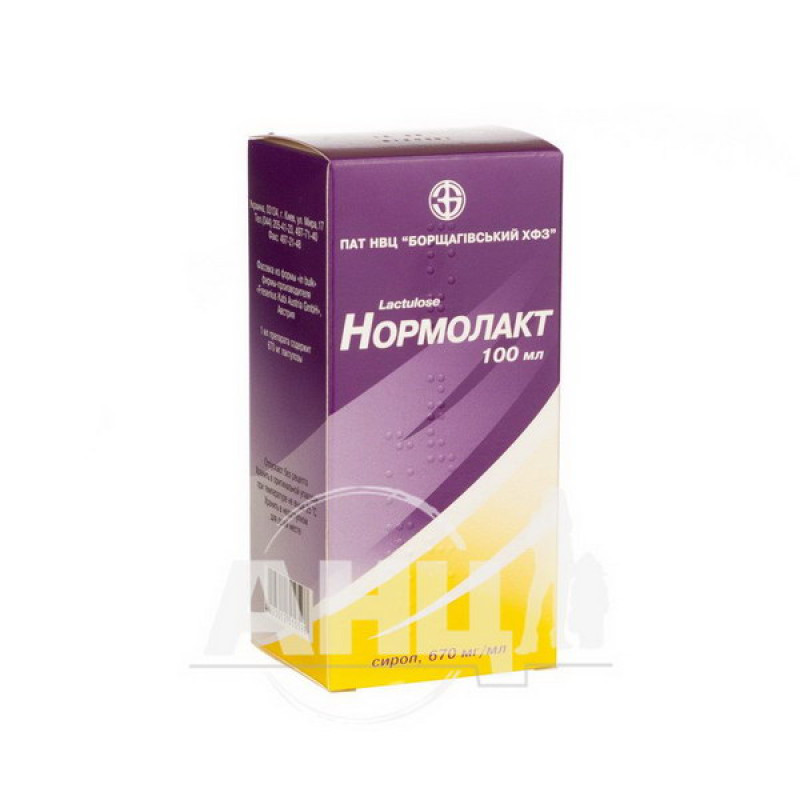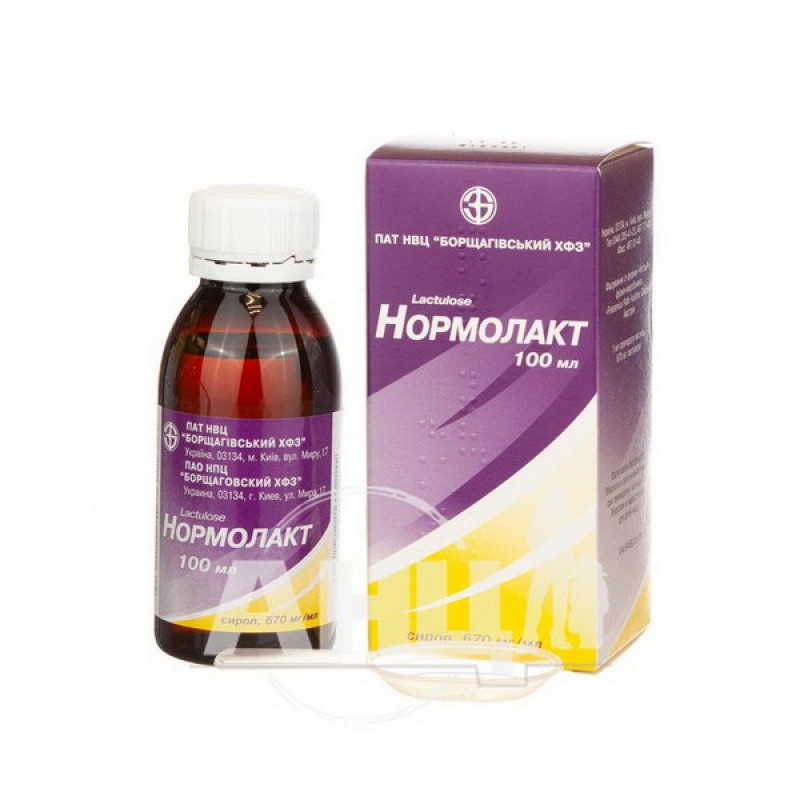Normolact syrup jar 100 ml

Pharmacological properties
Lactulose is a synthetic derivative of lactose. It is not broken down in the stomach and small intestine due to the lack of appropriate enzymes and is practically not absorbed. In the large intestine, lactulose is broken down under the action of microflora into low-molecular organic acids, as a result of which the pH decreases and osmotic changes occur that stimulate intestinal peristalsis. The volume of feces also increases and their consistency normalizes, which contributes to the process of physiological defecation.
By stimulating the growth of bifidobacteria, the growth of pathological intestinal microflora is inhibited and, as a result, intoxication with the products of their metabolism is reduced. As a result, the drug has a laxative effect and normalizes intestinal function.
In hepatic encephalopathy or hepatic coma (precoma), the effect of the drug is achieved through the following mechanisms of action:
suppression of proteolytic bacteria; increase in the number of acidophilic bacteria (e.g. lactobacilli); cleansing of the intestines due to low pH; osmotic effect; reduction of the number of nitrogen-containing toxic substances by stimulating bacteria that bind ammonia in the process of protein synthesis; fermentation of lactulose in the colon under the action of normoflora bacteria leads to acidification of the intestinal contents, which prevents the absorption of ammonia by the colon; in the presence of lactulose, colon bacteria do not use amino acids as a source of energy, which sharply reduces the accumulation of toxic products of protein metabolism.Normolact has the property of inhibiting the growth of salmonella in the large intestine. It does not reduce the absorption of vitamins and is not addictive (weakening or lack of effect with prolonged or repeated use).
The drug is practically not absorbed in the intestine and at a dose of 40-75 ml is completely metabolized by bacterial flora. When used in higher doses, part of lactulose may be excreted unchanged.
Indication
Constipation (including chronic); intestinal dysbacteriosis; intoxications of various genesis; hypercholesterolemia; hepatic encephalopathy; liver failure; hepatic precoma and coma; liver cirrhosis with a tendency to hyperammonemia.It is also prescribed for putrefactive dyspepsia syndrome in young children, pain syndrome after removal of hemorrhoids; to soften stools in hemorrhoids, if surgical intervention on the colon / anus is necessary.
Application
Take orally. The dose is set individually depending on the patient's condition. Treatment should begin with the maximum dose, which is reduced after 2-3 days or after achieving the desired effect. In the absence of effect within 2-3 days, the initial dose may be increased.
Recommended doses *
| Adults and children over 14 years old | 15-45 | 10-25 |
| Children 7-14 years old | 15 | 5-10 |
| Children from 1 year to 7 years old | 5-10 | 5-10 |
| Children under 1 year old | 2.5-5 | 2.5-5 |
* For children under 1 year of age, the drug is measured according to the scale indicated on the attached dosing device. For children over 1 year of age and adults, for ease of use, the drug can be dosed with teaspoons (5 ml), dessert spoons (10 ml), and tablespoons (15 ml).
The entire daily dose is best taken in one go in the morning during breakfast. It can be mixed with fruit and vegetable juices or food mixtures. The effect can be observed after 1-2 days, which is due to the action of lactulose.
In hepatic encephalopathy, hepatic coma and precoma, the drug is prescribed in an initial dose of 30-50 ml 3 times a day (90-150 ml/day). The maintenance dose is set depending on the individual response (2-3 soft stools per day should be achieved). The dose is set individually and only by a doctor.
Contraindication
Hypersensitivity to the drug; galactosemia; intestinal obstruction.
Side effects
Normolact is usually well tolerated, but sometimes during treatment (most often at the beginning) the following may occur: flatulence; nausea; diarrhea; headache; dizziness; increased fatigue; weakness; with prolonged treatment in high doses - disturbances of water and electrolyte metabolism; very rarely - muscle pain and arrhythmia.
Special instructions
The drug should not be used for abdominal pain, nausea and vomiting. With the appearance of diarrhea, treatment is discontinued.
It should be used with caution in patients with diabetes. In gastrocardial syndrome, the dose should be increased gradually to avoid flatulence. With long-term treatment (6 months), the level of electrolytes in the blood plasma should be regularly monitored, especially in elderly and debilitated patients. Patients with lactase deficiency should monitor sugar intake when using the drug.
Use during pregnancy and breastfeeding. Normolact can be used during pregnancy and breastfeeding.
Children. Normolact is used in children.
Ability to influence the reaction speed when driving vehicles or working with other mechanisms. Taking Normolact does not affect the ability to drive vehicles and engage in other potentially dangerous activities that require increased concentration of attention and visual acuity.
When taking Normolact with enteric-coated drugs of pH-dependent release, it should be remembered that lactulose lowers the pH of the intestine.
When used simultaneously with broad-spectrum antibiotics or antacids, the therapeutic efficacy of lactulose may be reduced.
It is not recommended to take Normolact within 2 hours of taking other medications.
Overdose
When taking the drug in very high doses, abdominal pain and diarrhea may occur.
Treatment: reduce the dose or discontinue the drug.
Storage conditions
In a dry place, protected from light, at a temperature of 15-25 °C.
Translation of the instructions can be
There are no reviews for this product.
There are no reviews for this product, be the first to leave your review.
No questions about this product, be the first and ask your question.






